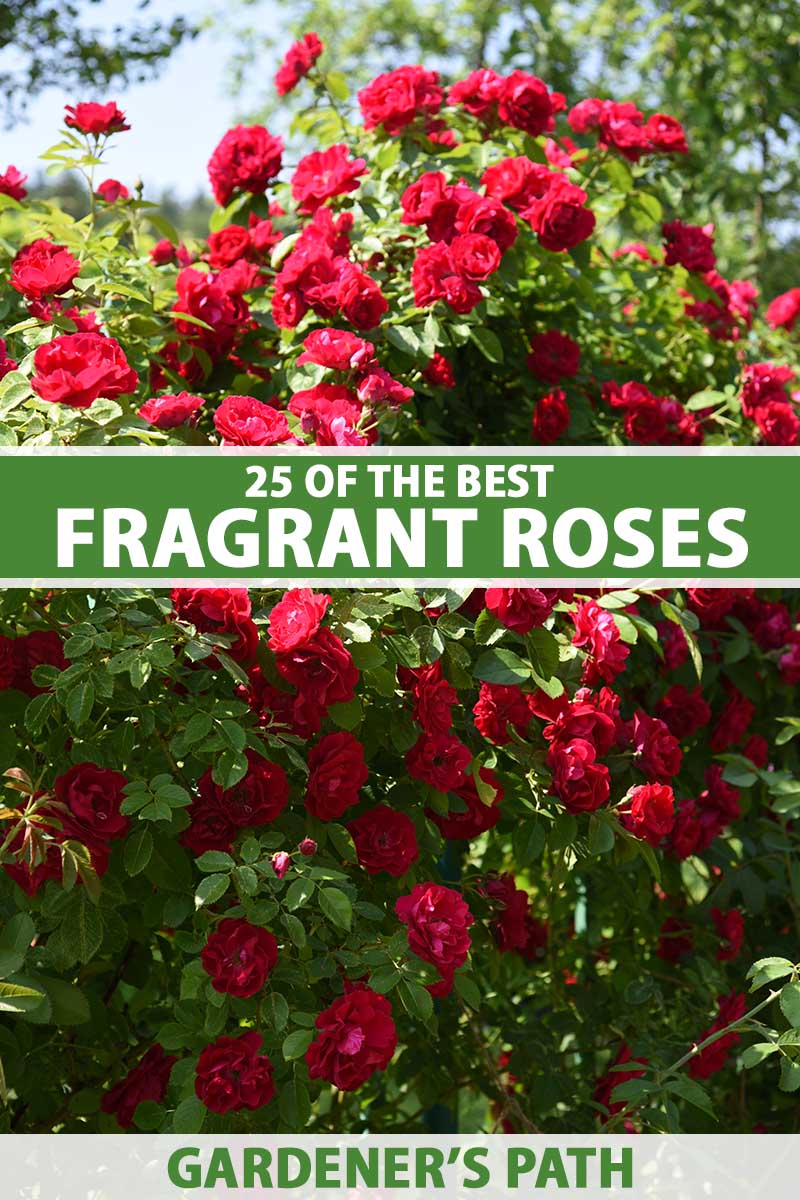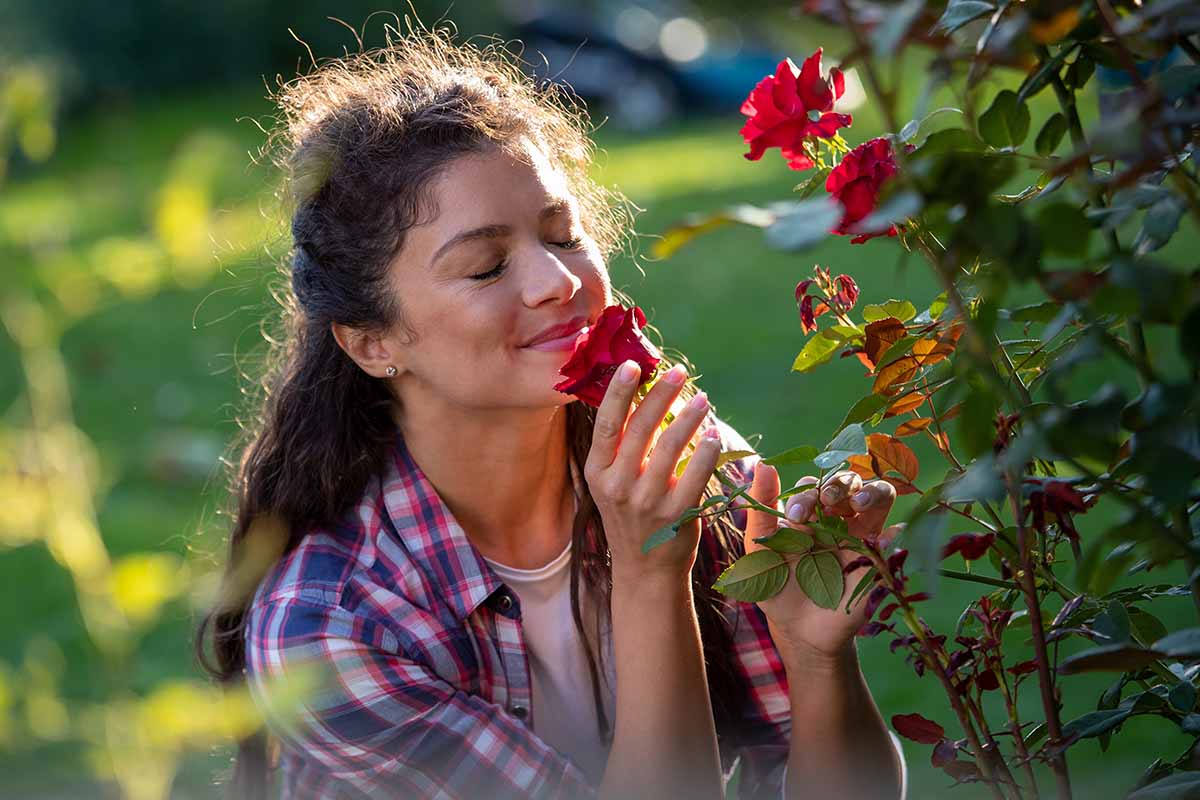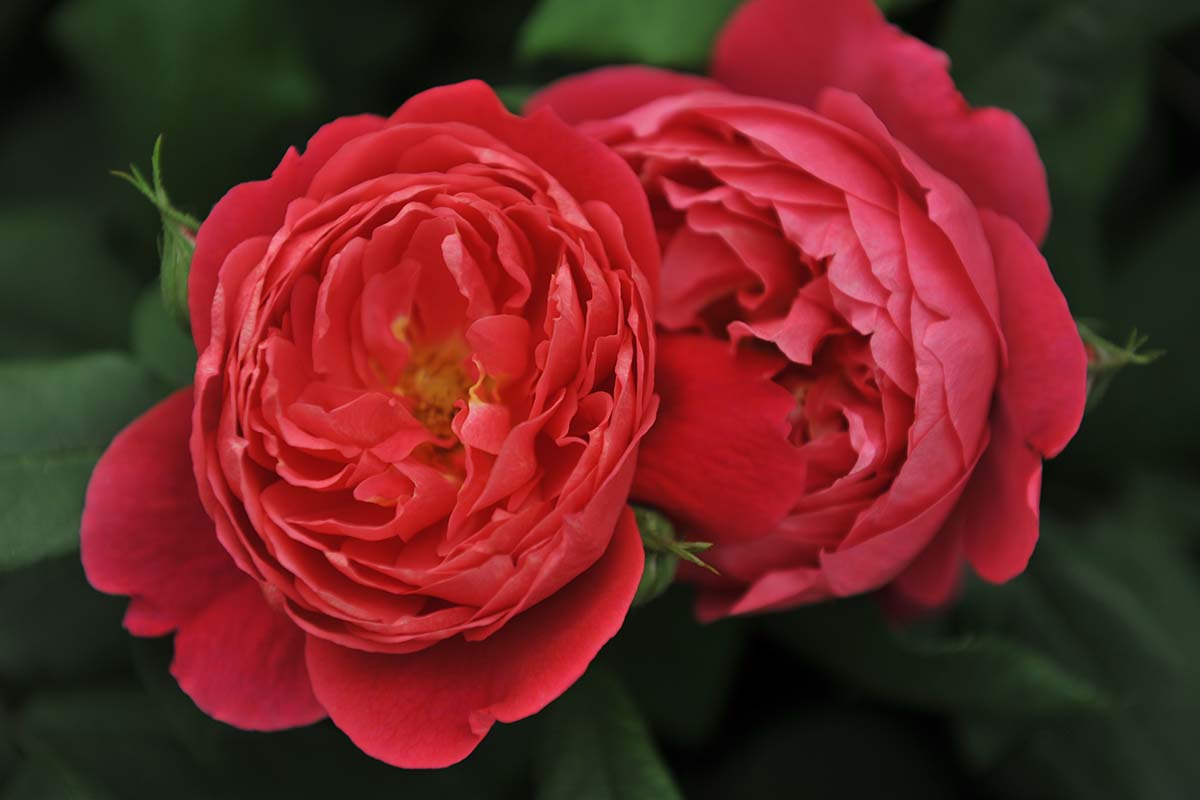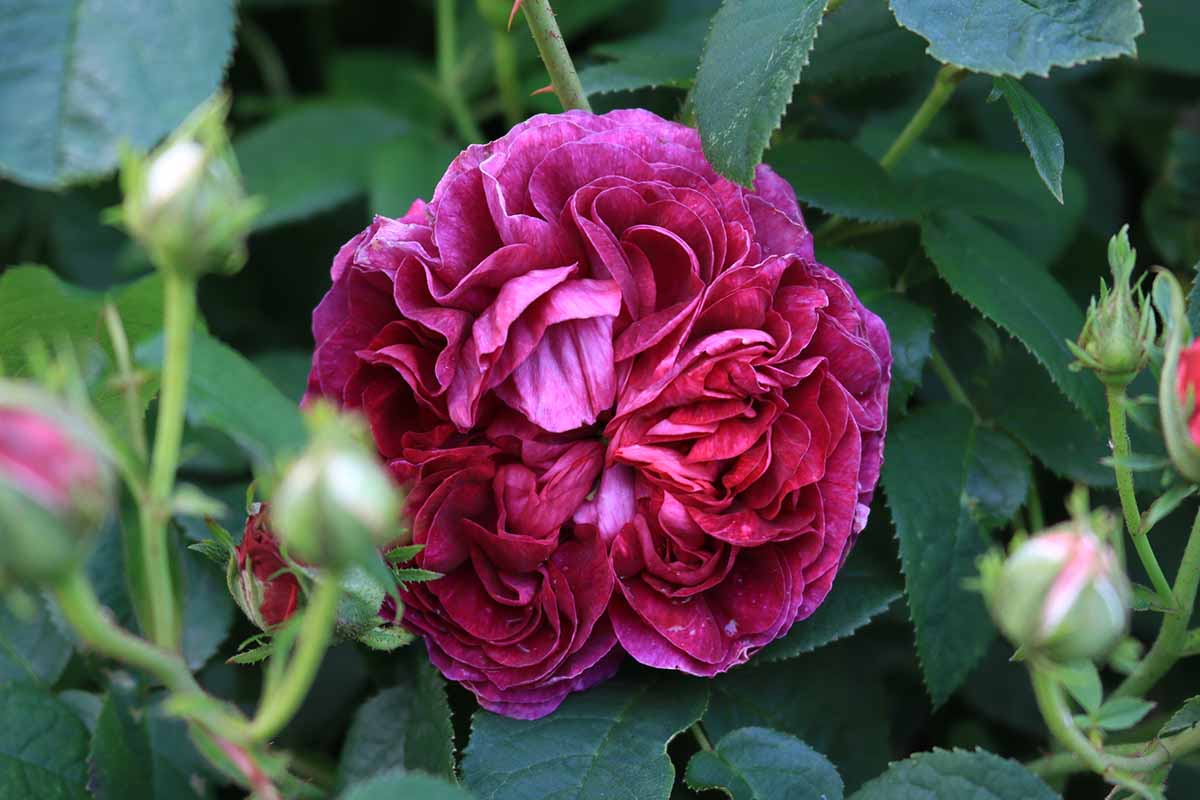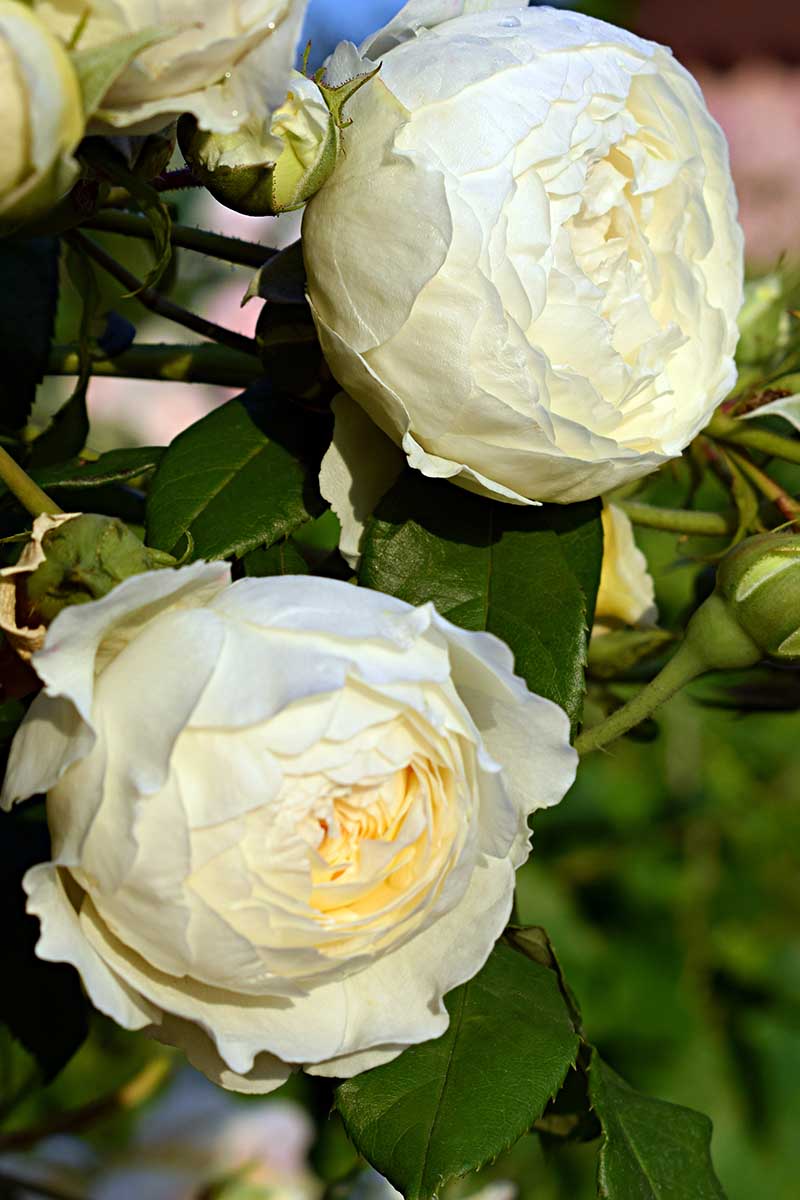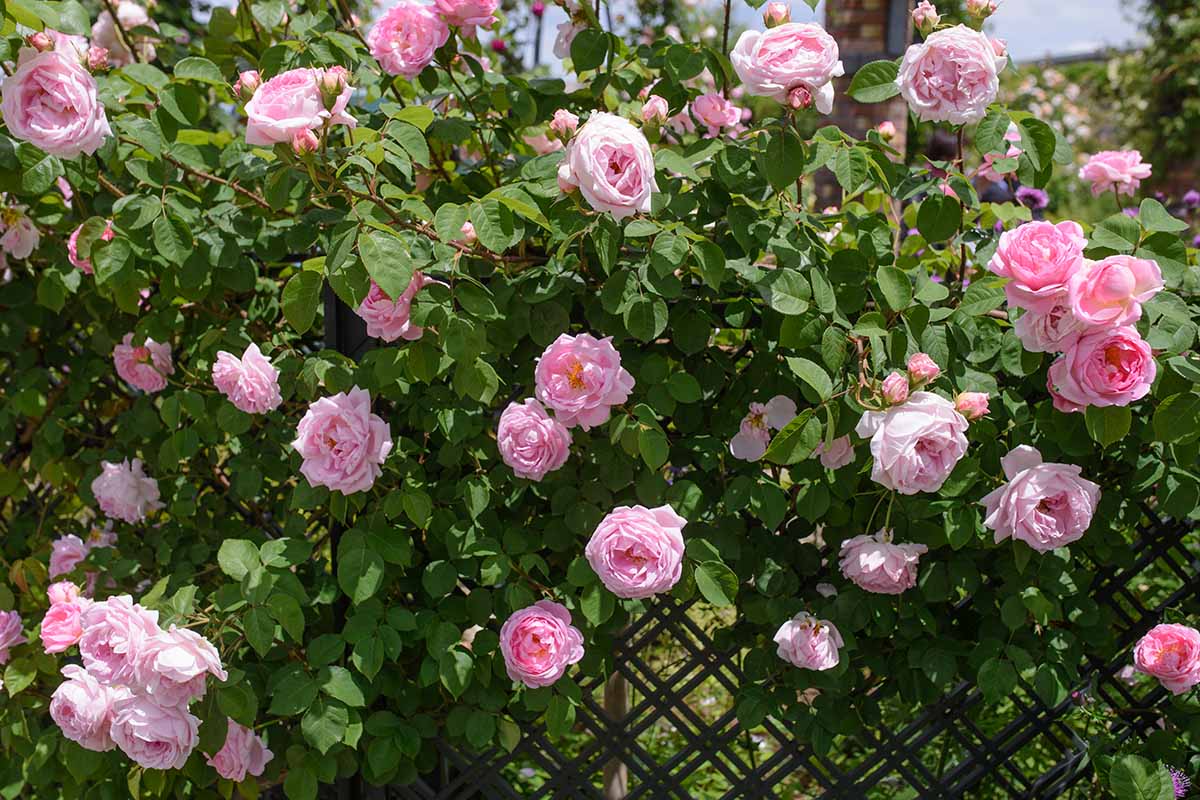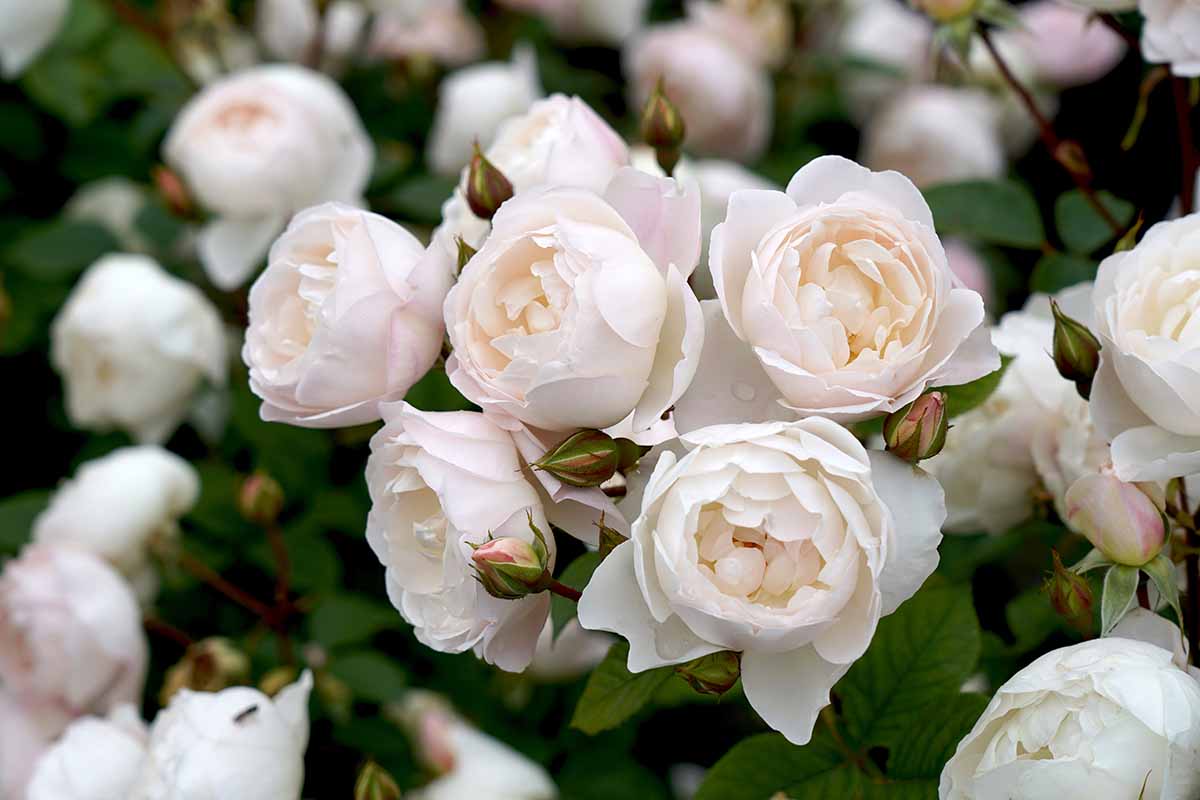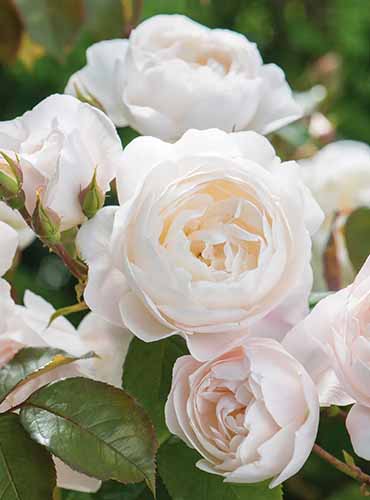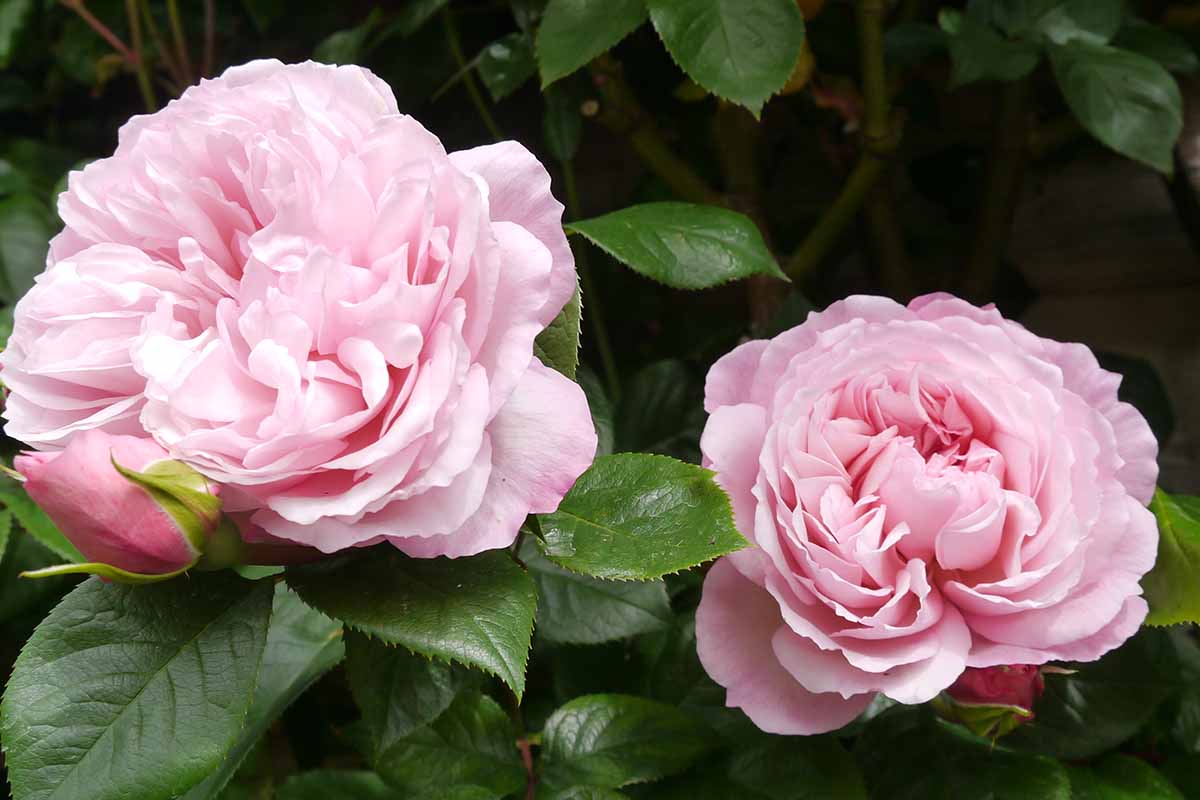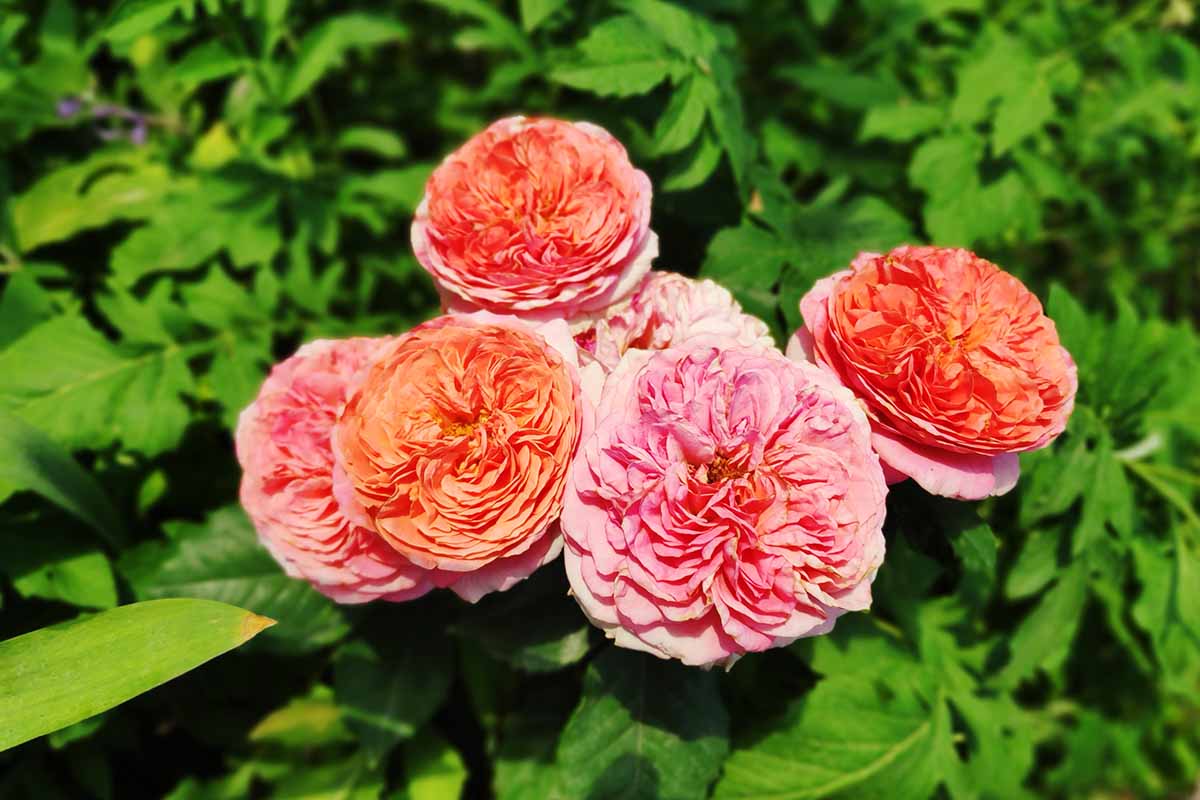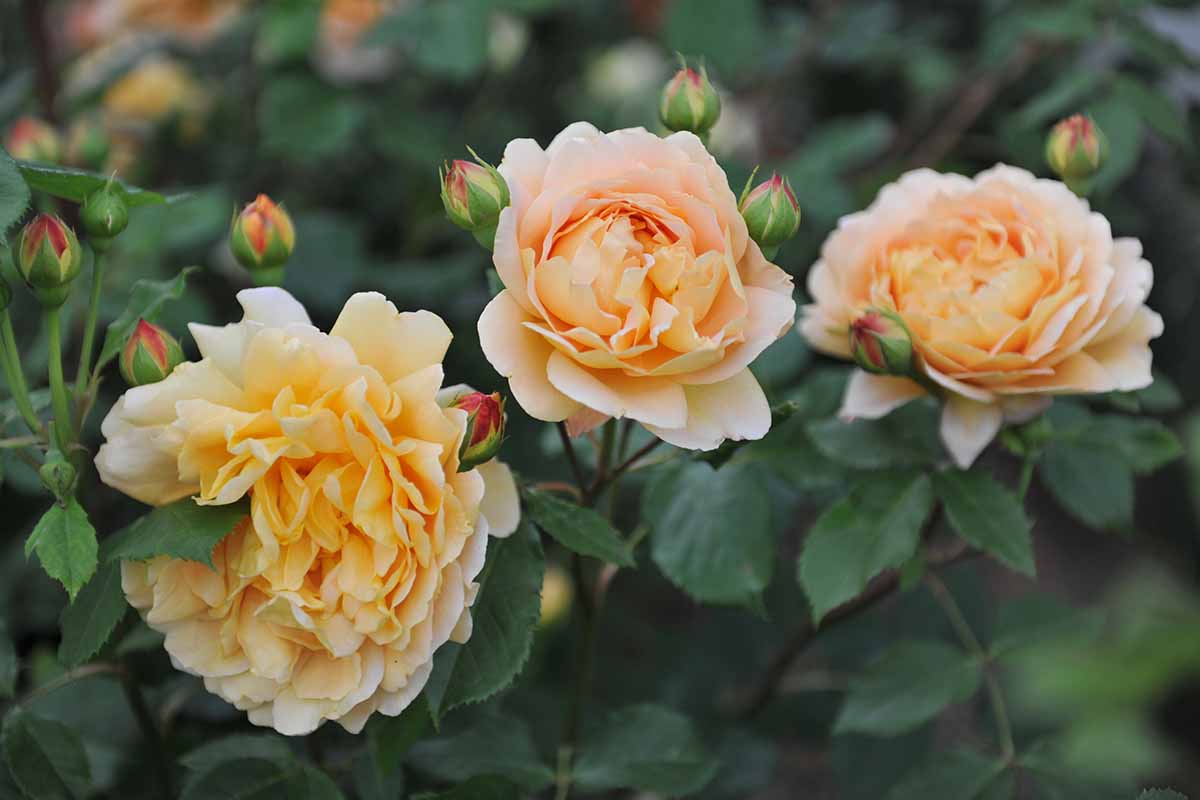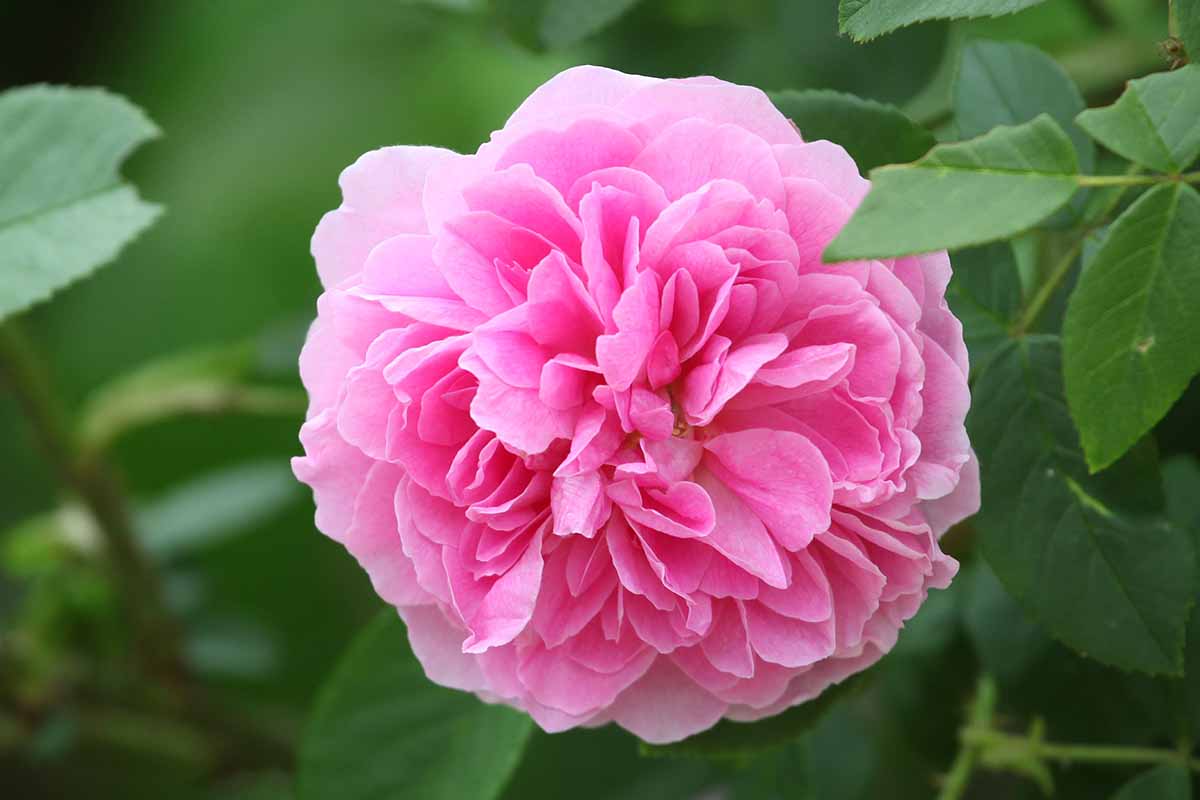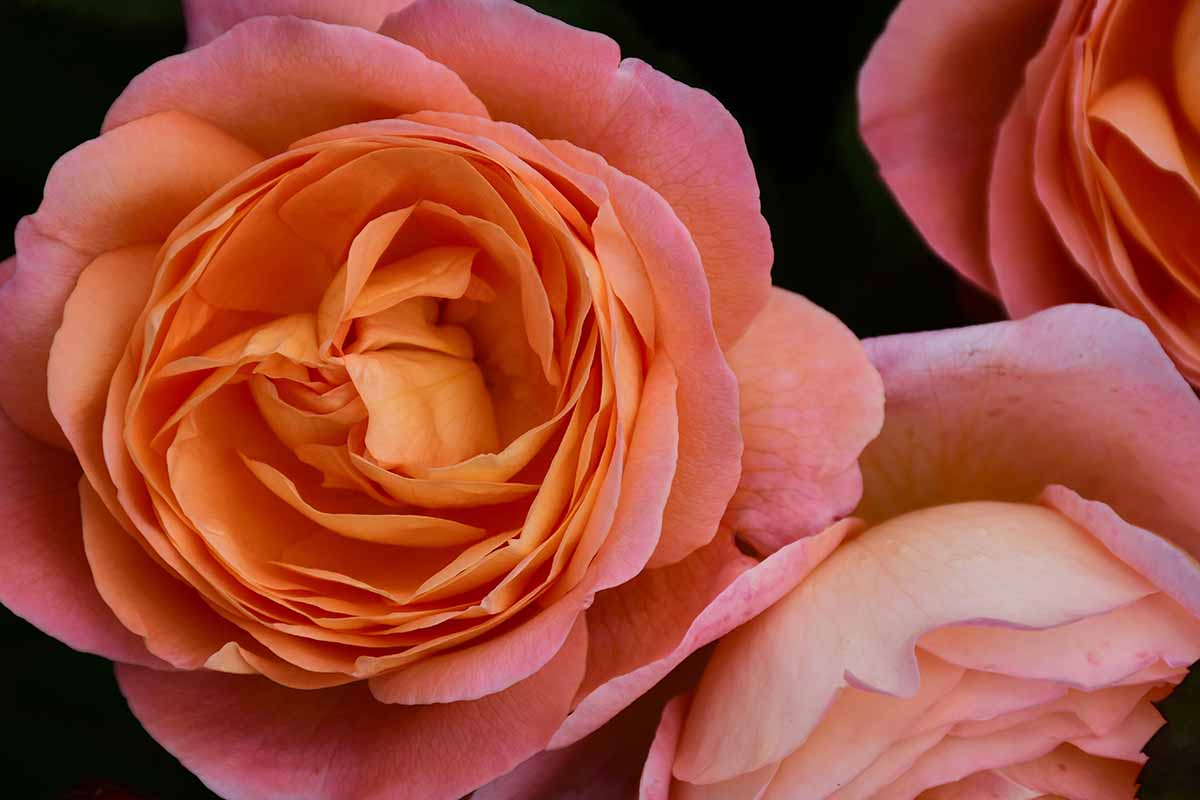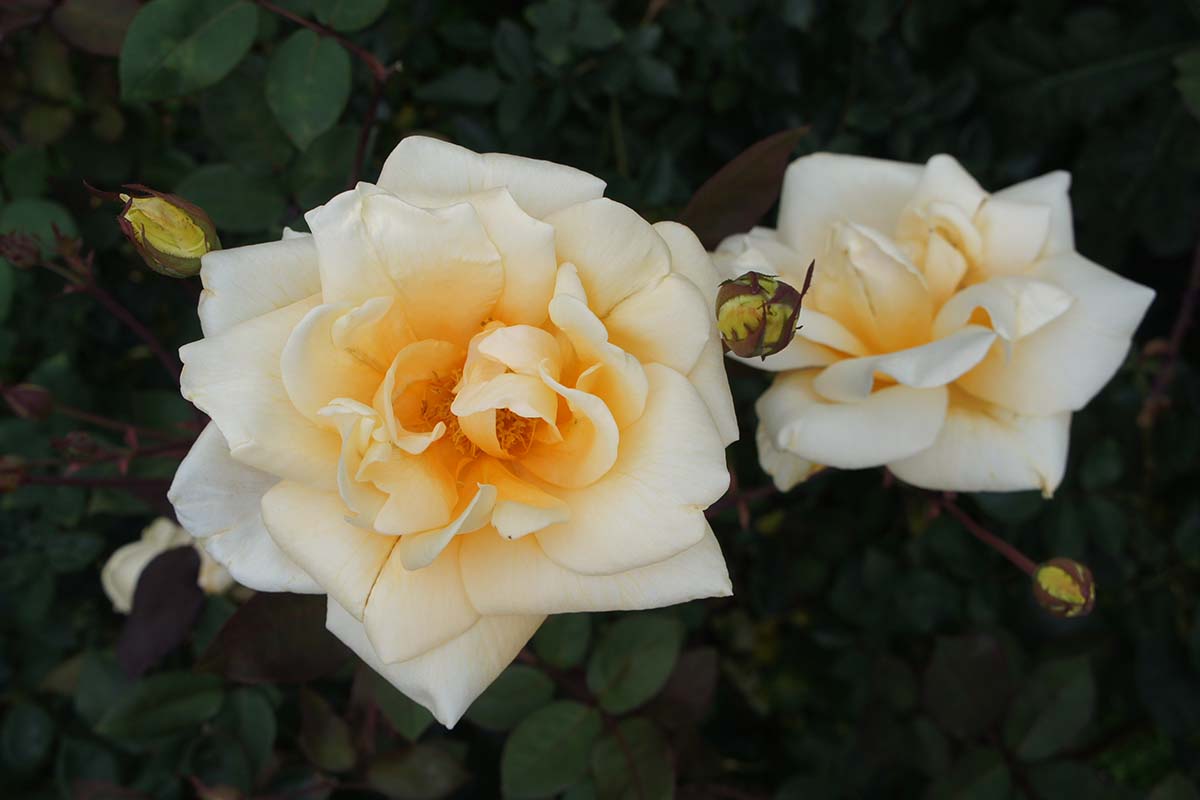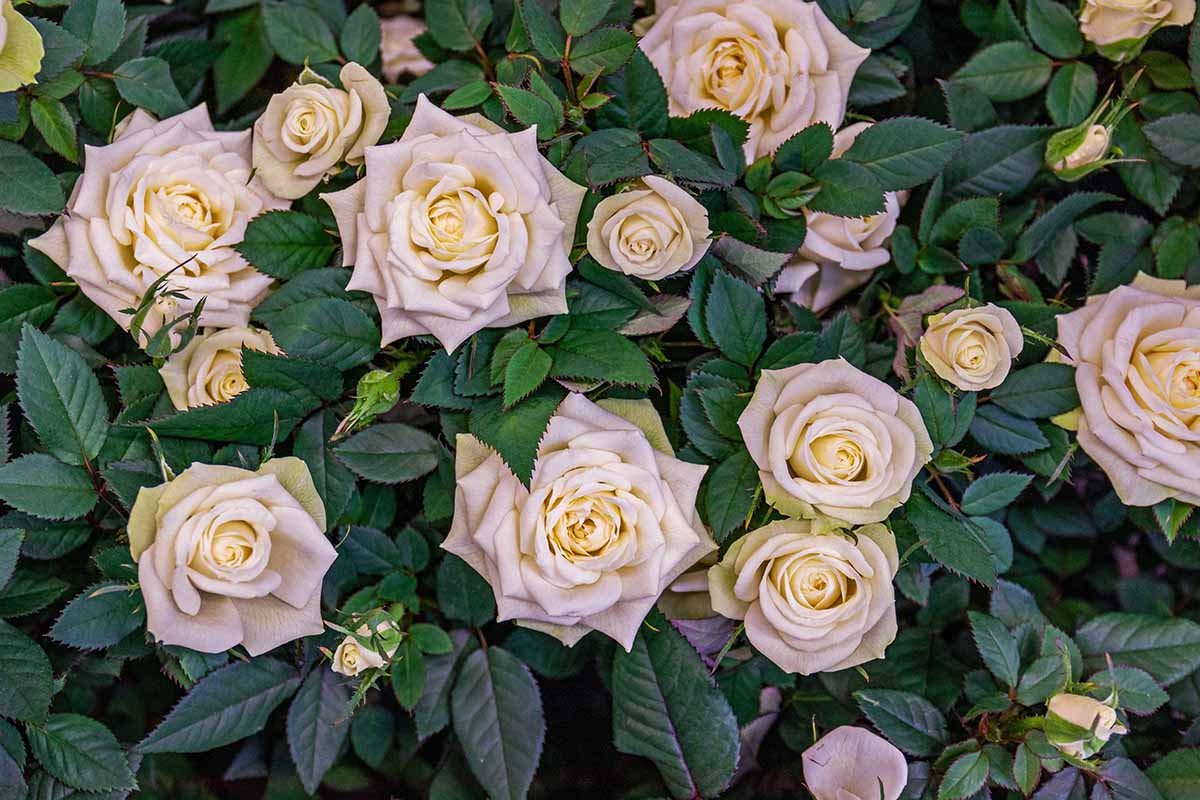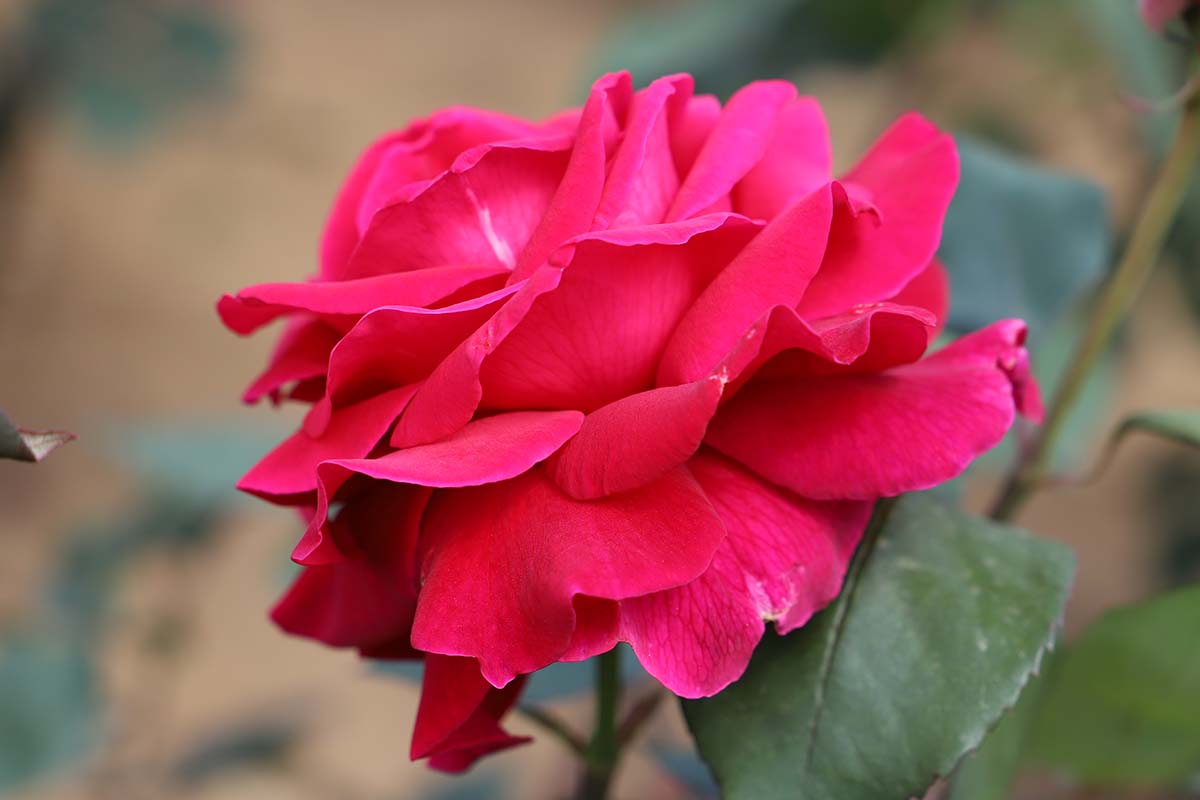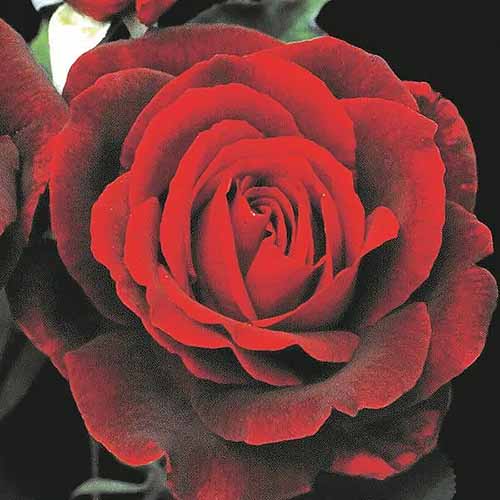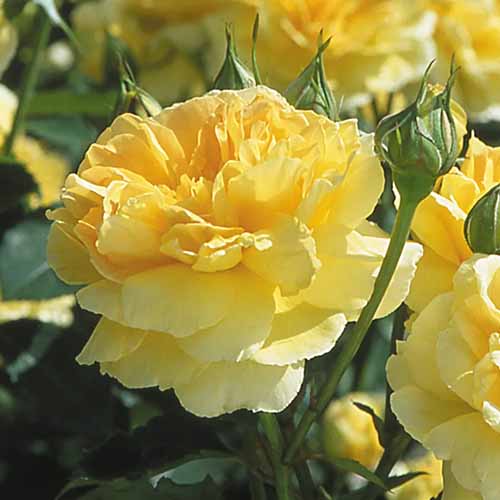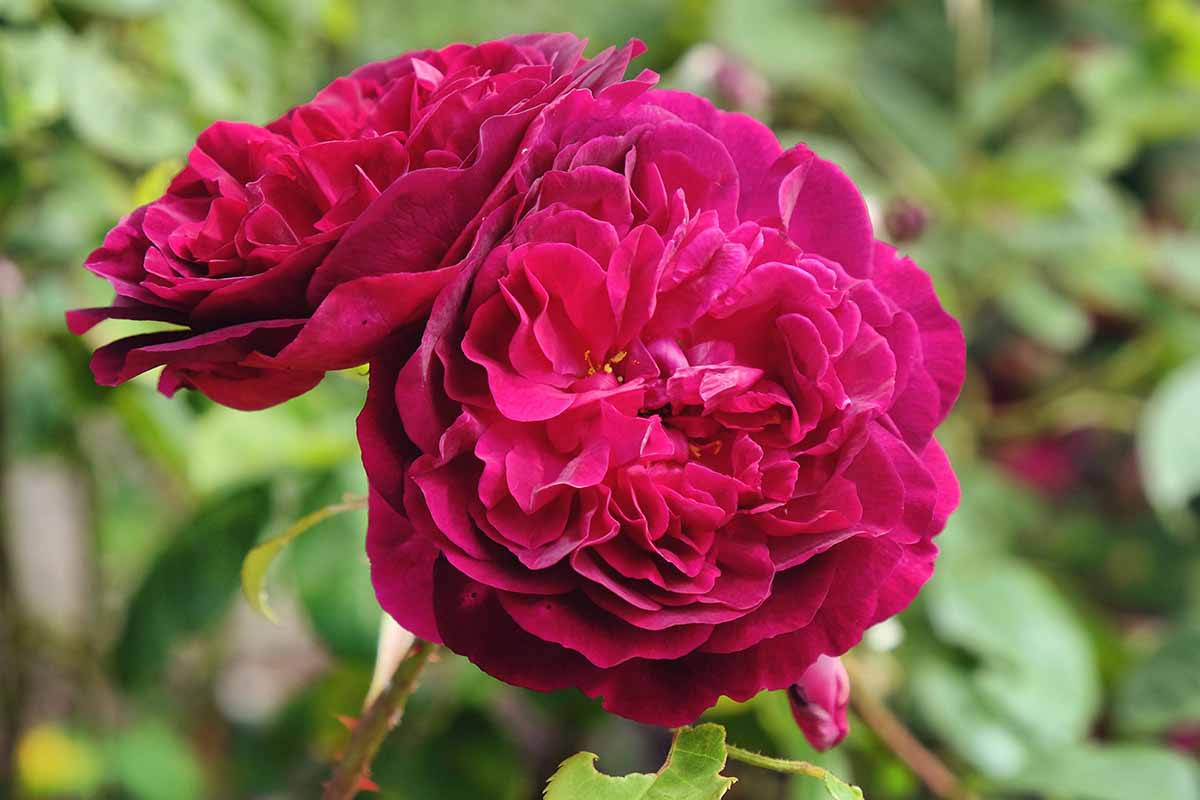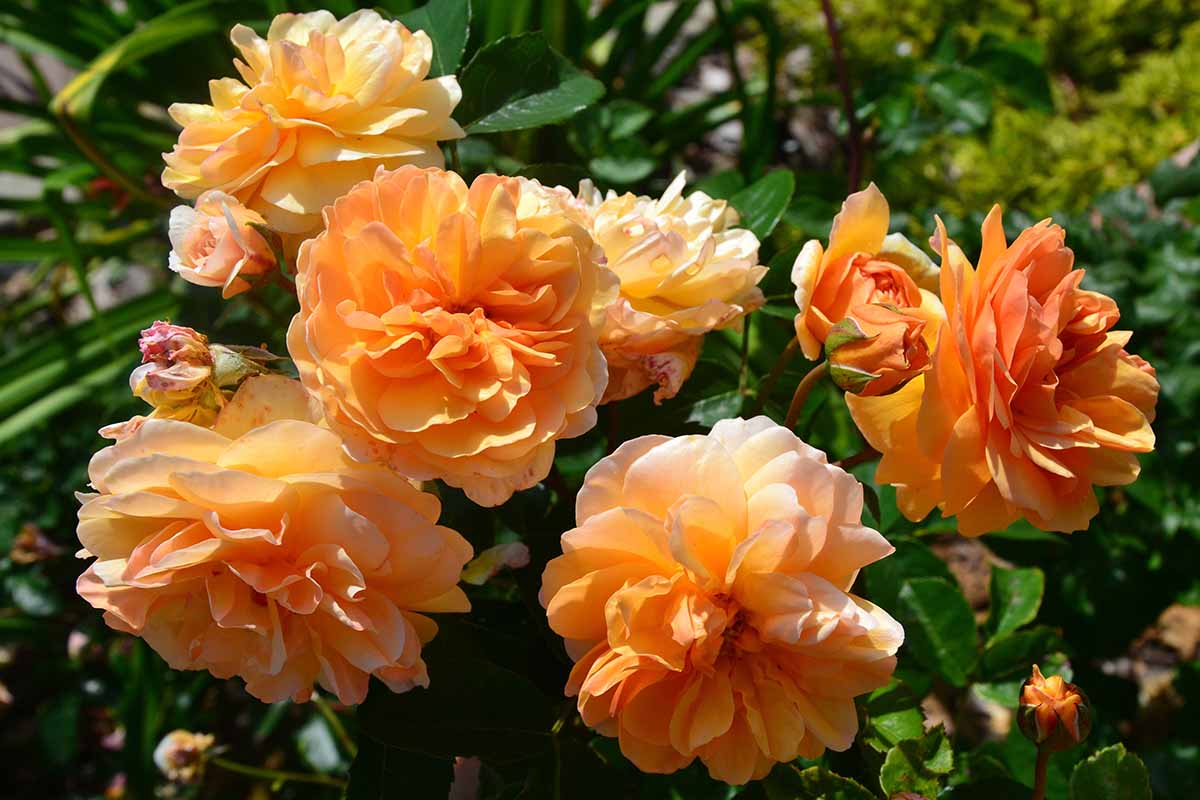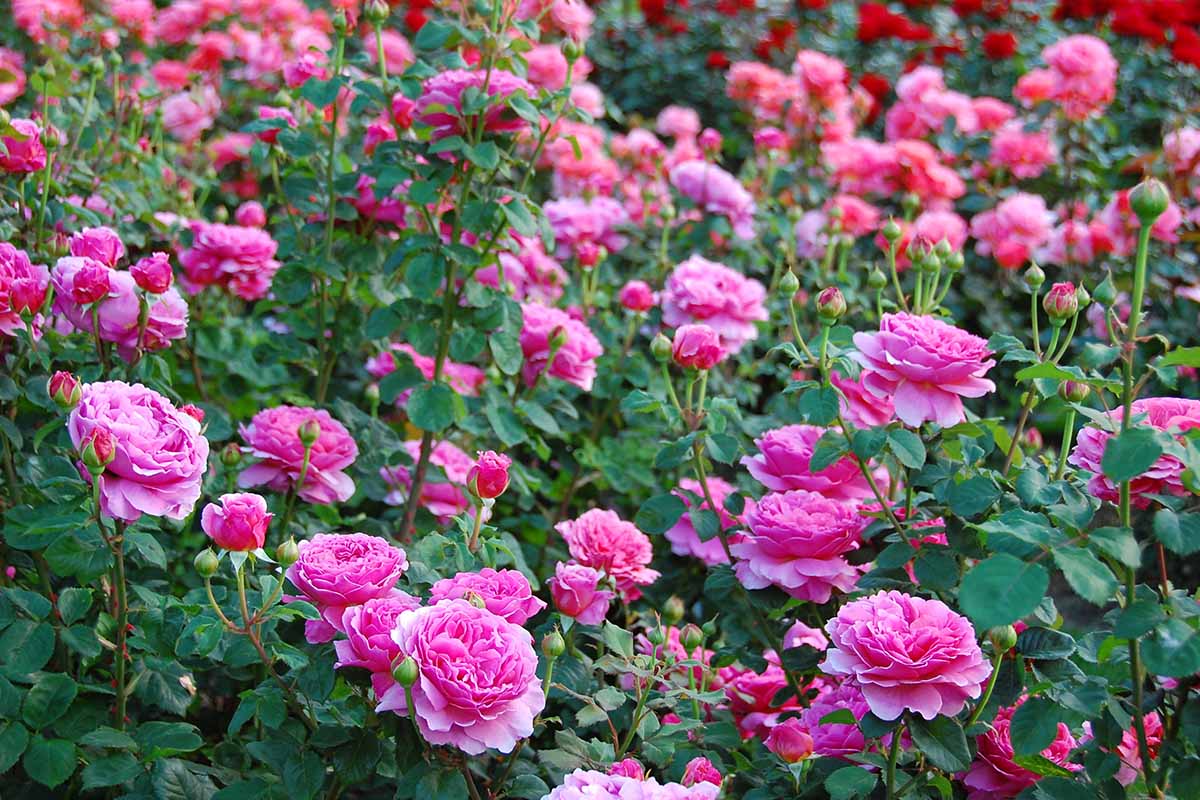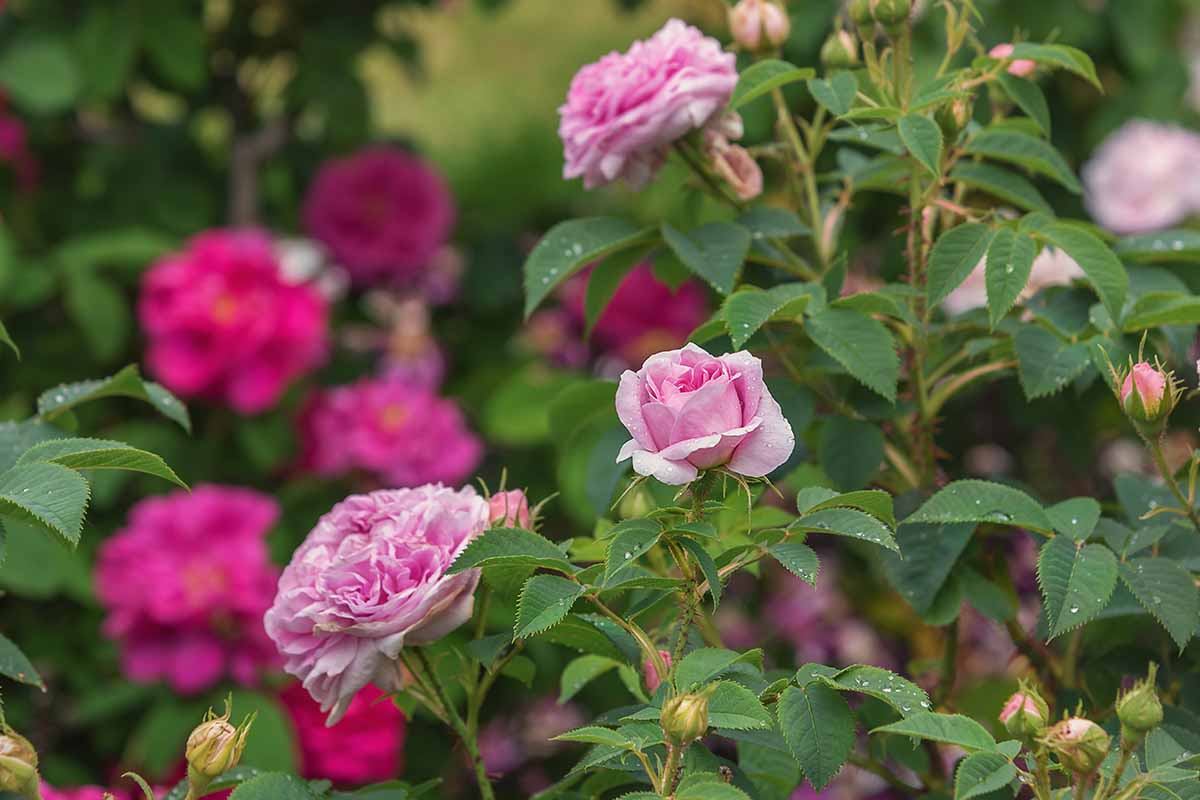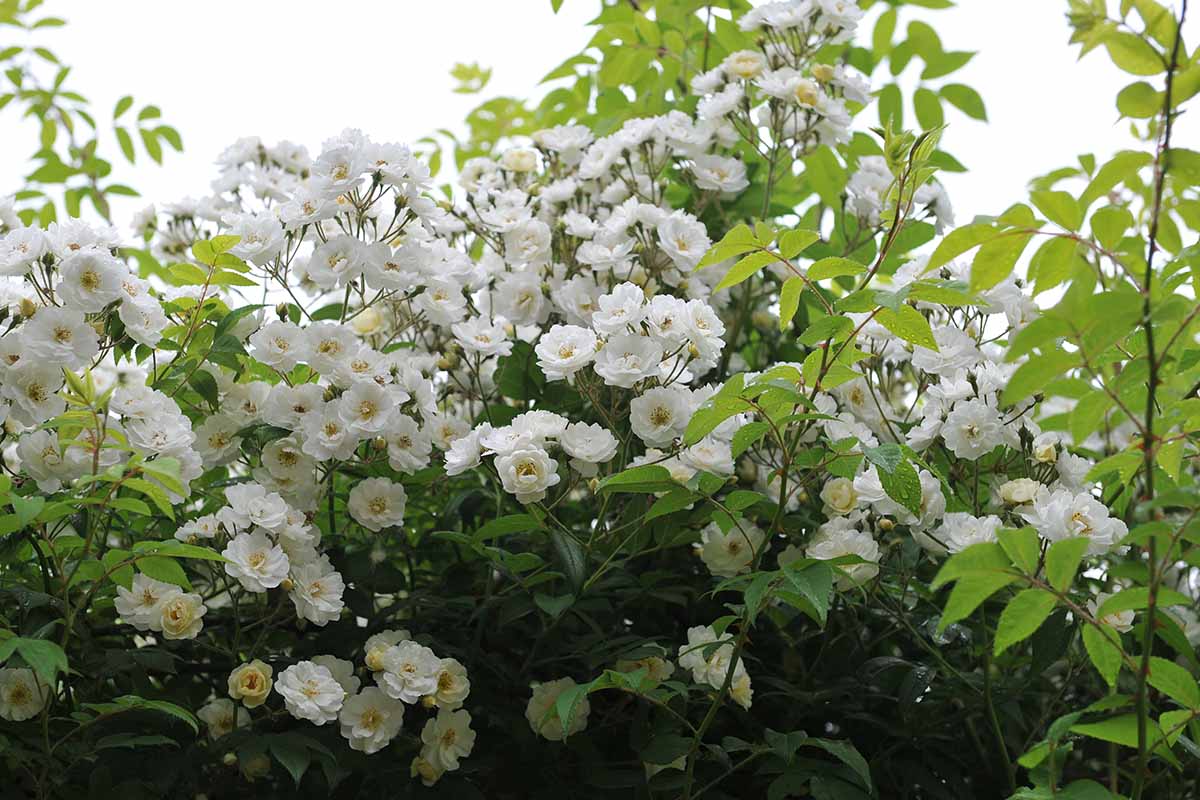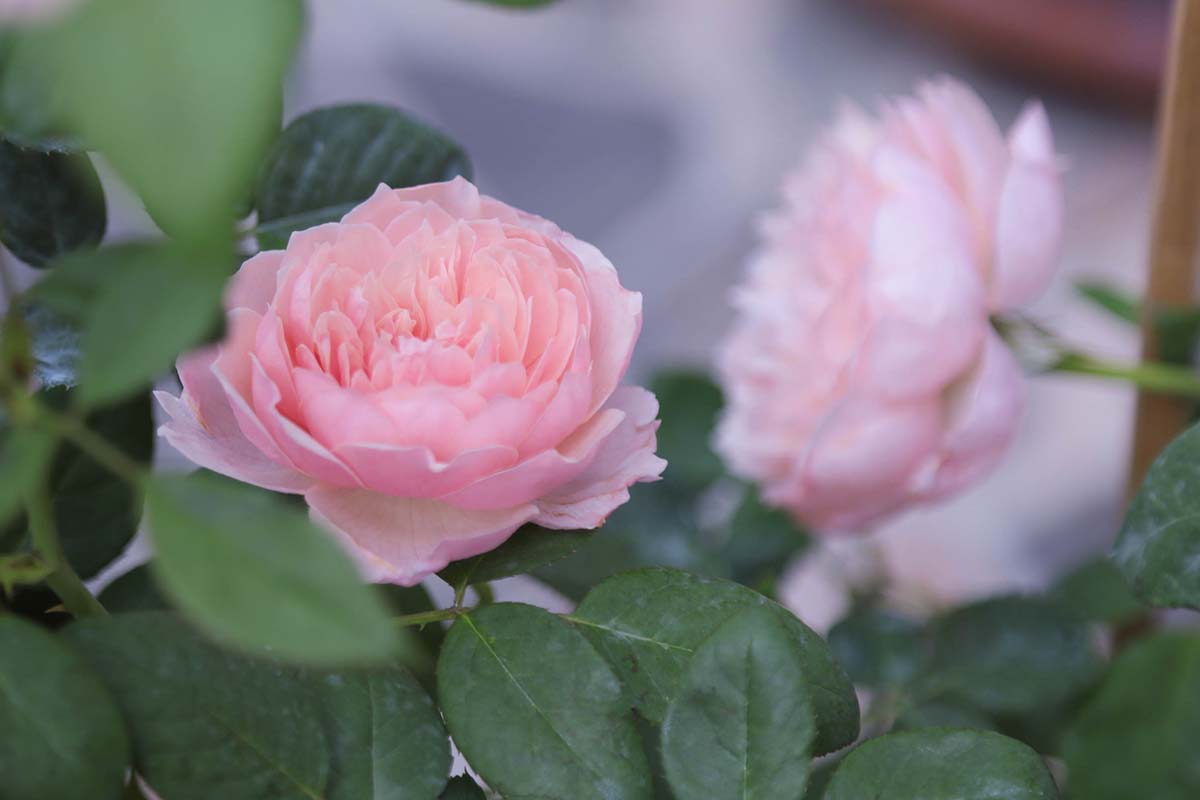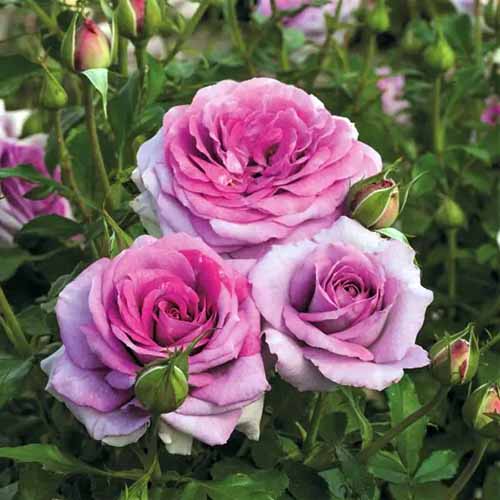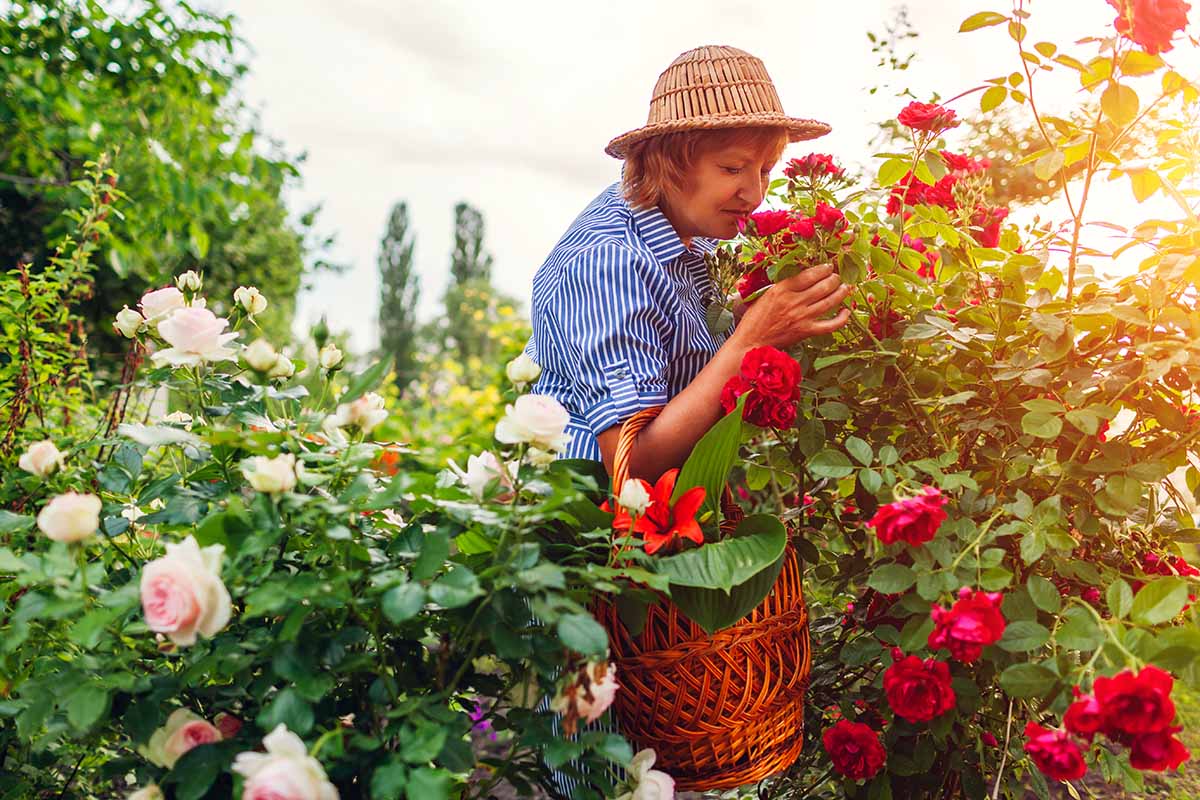That might sound like a pretty straightforward ask, but let me stop you right there. What exactly are you looking for? We link to vendors to help you find relevant products. If you buy from one of our links, we may earn a commission. Perhaps you prefer something that smells like a fine wine, or a bowl full of ripe blackberries left in the sun. Roses come in a bouquet of fragrances, colors, and growing habits, so feel free to peruse the following list to learn about what we believe are some of the most intense-smelling options commercially available. While we love them for their hardiness, long blooming time, and disease resistance, Knock Out roses don’t have a scent, which is something that rose purists find unappealing about the brand. Avoid them if you’re looking for fragrance. David Austin roses, on the other hand, are quite often highly fragrant. You’re going to see a lot of them on this list. The company even hired experts to come in and help identify the scents of their flowers, so you’ll often see descriptions rivaling those of fine wines. Broadly speaking, darker flowers and those with velvety petals generally smell the strongest, as do those with flowers that have more than 50 or so petals per flower. When you go out shopping for roses, do it in the morning. They’re most fragrant before the afternoon heat causes the volatile oils to dissipate, so you’ll really be able to discern all the individual notes. It also helps to compare plants to one another because this helps you to pick out individual notes that you might not have noticed otherwise. Most of the scents in these flowers come from some combination of citronellol, geraniol, nerol, and phenethyl alcohol. Most flowers maintain the same fragrance throughout their lives, but some are altered as they mature and the oils shift and change. By the way, when you think of the classic “rose scent,” be aware that growers classify the differences in scents as old (or classic), tea, myrrh, musk, or fruit. Old roses have that classic sweet, floral aroma that you probably imagine when you think of these flowers. The plants used to produce perfume come from this category. Gallicas, Albas, Rugosas, and Damasks are all common options, and red and pink shrubs are most likely to carry this fragrance. Teas have a floral scent mixed with the aroma of black tea leaves. Look for teas, some David Austins, and Noisettes in this category. Myrrh is often likened to sweet anise with a hint of camphor (it’s named for the herb, not the resin) and I’ve known more than one person who can’t stand the smell. You’ll mostly find only David Austins with this fragrance, particularly the orange, pink, and yellow types. When it comes to fruity roses, these can run the gamut from grape or guava to raspberry or banana. Pretty much any fruit you can imagine has a corresponding rose. Once again, it’s those English types by David Austin that dominate this category. Finally, musk-scented types are a little different. That delicious fragrance doesn’t come from the petals; it comes from the stamens. Most people say that these smell best from afar, while up close the clove and floral fragrance that reminds us of the musk perfume of yore can be a bit intense. Ramblers are most likely to carry this scent. Keep in mind that we all interpret smells differently, and what I notice might not be what stands out for you. Take these descriptions as a guide to help you find the fragrant types you might want to plant at home.
1. Benjamin Britten
If you love the scent of pears – or even better, pear candy and wine – ‘Benjamin Britten’ is for you. The deeply cupped, fully double cherry red flowers are eye-catching and, like a beautiful piano concerto, are a feast for the senses. This is a David Austin cultivar that does well in partial sun down to Zone 4.
2. Boscobel
With huge, fully double coral-pink flowers, ‘Boscobel’ doesn’t need any fragrance to be enticing. But it’s all the better for the almond, myrrh, and pear notes that greet the nose when you walk by. If you examine the blossoms closely, you’ll notice hints of yellow and apricot amongst the pink, and these colors are all the more intense towards the center. This English type is happy down to Zone 5 and is a repeat flowering wonder that will bring color to your garden all summer long.
3. Charles de Mills
Before we talk scent, we need to chat about how beautiful ‘Charles de Mills’ is. I literally stopped in my tracks and did a double-take when I first saw a shrub covered in the very double, bold mauve flowers. I wasn’t sure if I was looking at a particularly full peony or what, because the flower heads are so packed with petals that it seems impossible to squeeze in even one more. White roses are difficult to breed, which is why it’s hard to find exceptional examples of them. And lest you turn your nose up at this option because you assume it must be susceptible to disease, don’t worry. It’s incredibly resistant, which is one of the many reasons that this classic option has been in cultivation for centuries in Zones 4 and up. ‘Charles de Mills’
4. Claire Austin
Lemon yellow buds open up into heavenly cream-white blossoms that smell heavily of myrrh, vanilla, and meadowsweet. A climber named for David Austin’s daughter, this one stands out for its elegant perfection. But ‘Claire Austin’ couldn’t be better, with disease resistance, perfectly-formed flowers that appear all summer long, the ability to grow as a shrub or climber, and hardiness down to Zone 5. While it can be grown as a freestanding shrub, it looks best treated as a climber since the canes can reach up to 20 feet long. Not only are the double blossoms marvelous to behold, but the fragrance is like that of a sweet cup of tea. ‘Compassion’
6. Constance Spry
‘Constance Spry’ is one of the first roses that David Austin ever bred and it’s the foundation for so many of his English roses. While that’s a pretty impressive lineage, it’s also the first one that we are aware of that had an intense myrrh fragrance. Others had a subtle suggestion of myrrh, but it was this beauty, named after a pioneer of flower arranging, that really set the standard. The classic pink blossoms are full, appearing in the early summer, and the plant grows well in Zones 5 to 9.
7. Desdemona
If you find yourself partial to the myrrh-scented roses, ‘Desdemona’ is your gal, and you don’t even have to be Othello to win her. The flowers are as beautiful as their namesake, and the buds start out peach before fading to pale pinkish-white as they open. You have David Austin to thank for this climber, which looks particularly nice growing up a wall as the flowers tend to extend outward on the stems and nod in the breeze. The strong, long stems make this cultivar particularly good for cutting, and the shrub has an extremely long flowering season, which means it will outlast the tragic heroine it was named for. ‘Desdemona’ Need some ‘Desdemona’ in your life? Pop on over to Burpee and nab a bare root plant.
8. The Generous Gardener
The gardener might be generous, but in this case, it’s the rose that is doing all the giving. Hold a blossom to your nose and inhale. You’ll be treated to intense old rose, myrrh, and musk on pale petals that belie their bold fragrance. The drawback is that this cultivar doesn’t do well in warmer regions. It’s ideal for Zones 5 to 9, however.
9. Gertrude Jekyll
David Austin found a magnificent way to honor the horticulturalist and garden designer Gertrude Jekyll. The rose named for her is one of the first to pop out in the spring, with large, deep pink flowers. It can be grown as a bush or as a climber in Zones 4 and up, which is excellent because you’re going to want this one to reach right up to your bedroom window so you can smell the incredible flowers all night long. They have a strong scent of heady, classic rose, and since each bush is absolutely smothered in blossoms, you can identify this beauty from a long way off. No wonder BBC Gardener’s World viewers in the UK voted it their favorite two different times.
10. Golden Celebration
If you love the sunny warmth of yellow roses, then break out the celebratory champagne, because you’re going to adore this one. By the way, the flower wasn’t actually named after the Norse term but for a garden in north Yorkshire, lest you be left wondering how on earth it earned this moniker. The petal color is a rich, golden yellow that doesn’t fade as the blossoms age. Additionally, if you like to use your roses for eating, this is a particularly good one to try. The petals have a subtle tea scent with strong notes of strawberry and red wine (Sauternes, if you want to be specific), which becomes stronger as they age. It’s also mostly thornless. ‘Golden Celebration’
11. Harlow Carr
If you want a pure old rose scent, pick ‘Harlow Carr.’ The name, which means “stinking bog” in old Norse might put you off, but don’t give up. Press your nose to the petals and you’ll be treated with a bold fragrance that reminds me of a classic rose perfume or candle. The fully double blossoms are bright pink on a vigorous shrub. If you guessed that this stunner was bred by David Austin, you’d be right. Perfect for those in Zone 4 and up, it’s ideal for cutting gardens.
12. Lady Emma Hamilton
As beguiling as the lady herself, this Austin cultivar looks as good as it smells, with berry and citrus overlaying the classic rose scent. The lady changes her cloak as each blossom matures, transitioning from a blood-red bud to tangerine orange, full flowers that are slightly lighter at the center. The foliage on the plant is particularly glossy and large. This lady is happy in Zone 5 and up.
13. Lady Hillingdon
To me, fragrant climbing roses are just about the best thing in a garden. Whether scrambling up next to a window or covering an unsightly wall, they completely transform a place into something out of a novel centered in the English countryside. But then you add in some intense fragrance, like the classic tea of ‘Lady Hillingdon,’ and it’s truly transformative. The apricot yellow blossoms on this century-old cultivar are loose and open, and they contrast beautifully with the glossy, dark bronze-green leaves that would impress even the most jaded baroness. In fact, the only flaw in ‘Lady Hillingdon’ is that it’s only suitable for Zones 6 and up. Sorry to all those living in chillier spots!
14. Madame Anisette
Many Grandifloras have a nice fragrance, but ‘Madame Anisette’ takes it to the next level. This cultivar has a licorice, myrrh, honey, herbal scent with just a faint hint of rose. The full blossoms on this Kordes rose are pale peach at the exterior and apricot in the center. As with most Kordes cultivars, it’s hardy, and pest and disease resistant. This lovely lady is part of their Parfuma series and is often regarded by rose lovers as one of the best. Suitable for Zones 5 and up.
15. Mister Lincoln
‘Mister Lincoln’ has been around since the 1950s and continues to be one of the most popular options out there. It’s easy to see why. The Austin-bred plant is a vigorous grower, with glossy leaves that turn from bronze to deep green as they mature. The downside is that this cultivar does best in Zones 7 to 11, so those in cooler regions will have to look elsewhere. ‘Mister Lincoln’ Ready to add this regal option to your garden? Nature Hills Nursery can help.
16. Molineaux
‘Molineaux’ makes all the other roses jealous with all the awards they’re constantly bringing home. The most relevant to our list is the Henry Edland Medal for the Best Scented Rose. ‘Molineaux’ The large, double blossoms in bright yellow smell like musk and tea. And this English plant is hardy to Zone 5. Burpee can make your dreams come true, since they carry this option as a bare root.
17. Munstead Wood
You’d be hard-pressed to find a fragrant rose with a more delightful scent than ‘Munstead Wood’ if you prefer something fruity and sweet. With a base of classic rose, it has notes of blackberry and plum that add a bit of bright sweetness. The blossoms are deep crimson and full, gradually transitioning from cupped to semi-cupped as they mature. Bred by David Austin and suitable in Zones 5 to 10, this cultivar stays under three feet tall and wide, so it’s perfect for a container garden. This one was named for Gertrude Jekyll’s garden of the same name. ‘Munstead Wood’ Grab a bare root plant to add to your garden at Burpee.
18. Port Sunlight
With deep apricot petals at the center and pale peach on the exterior, this plant is like a sunny beacon that calls you to it. It has a bold tea scent and an extremely vigorous growth habit in Zones 5 and up.
19. Prairie Sunrise
A lot of modern roses have fully double, cupped blossoms that somewhat resemble peonies. While they’re stunning, sometimes you want something that looks a bit more traditional. This Buck rose has that beautiful, full shape that has been the hallmark of roses in classic paintings and photos. The pale apricot petals on the exterior give way to vibrant orange at the center, with an intense tea fragrance. As with all Bucks, this plant is vigorous, disease-resistant, and hardy all the way down to Zone 4.
20. Princess Alexandra of Kent
Some flowers maintain the same scent from beginning to end, but this one starts out with a subtle lemon scent before slowly transitioning to a blackberry, with an undercurrent of tea all the while. The flowers are intensely bright pink, cupped, and full, though the buds start out as a vibrant salmon color. The long stems lend nicely to cutting. This Austin-bred beauty is not only extremely hardy, down to Zone 4, but it will also bloom even when grown in shady conditions. It was named for Queen Elizabeth II’s cousin, who is a well known rose aficionado.
21. Queen of Denmark
This centuries-old cultivar is a stunner, with fully double quartered blossoms in classic pink. She has not stuck around for as long as she has because of her beauty alone. This old gal has substance. She is incredibly disease resistant, withstands neglect, and produces a massive flush of heavily old rose-scented blossoms in the early summer. Plus, the ‘Queen of Denmark’ is hardy enough that she can live even in the bitter Scandinavian winter in Zones 4 and up.
22. Rambling Rector
‘Rambling Rector’ is widely considered one of the best options if you want something with a ton of heady, clove-like scent. This climber doesn’t look like most other roses. It has clusters of small, double flowers with bright yellow stamens, and people often mistake it for white clematis at first glance. The plant has strong, woody growth that enables you to train it along a trellis or into a tree shape. Plus, it does well in shady spots and offers up fall interest in the form of masses of bright orange hips. This ramblin’ marvel is hardy in Zones 6 to 9.
23. Saint Ethelburga
One of the most fragrant roses out there, ‘Saint Ethelburga’ has an old rose scent carried on fully double, frilly, light pink flowers that stick around all summer long. It was bred by Peter Beales in 2003 and named for Abbess Æthelburh of Barking who died around 686, and the church that now honors her in London. The modern shrub grows happily in Zones 6 to 9. And like Lady Violet, this rose makes a strong impression. The flowers feature violet petals with a hint of magenta at the center of each blossom. Lean in to smell this floribunda (even if Lady Violet would not approve) and you’ll experience a strong, spicy, fruity fragrance. ‘Violet’s Pride’ And just like the stalwart matriarch herself, this rose is hardy enough to withstand temperatures down to Zone 5. Nature Hills Nursery carries this regal lady in a #3 container.
25. Wollerton Old Hall
‘Wollerton Old Hall’ is best inhaled in the early morning so you can really experience all the subtle notes that the flowers offer up. It smells of myrrh and grapefruit with a hint of apricot, from red and yellow buds that open to full apricot flowers before fading to cream. Austin says that it is one of the most fragrant of all his creations. And this is a climber, so you can train it along the fence in your favorite spot in the yard. The blossoms appear at the end of long stems, making it perfect for cutting. This cultivar blooms all summer long in Zones 5 and up, and I consider it a must-have if you want a beautiful climber with a unique fragrance, and with flowers that are absolutely ethereal.
Stop and Smell the Roses
There are far more options out there beyond the classic old rose fragrance that so many of our grandmothers doused themselves in – but, to be perfectly honest, I love a good traditional rose scent, too. I’ve smelled every single one on this list and you truly can’t go wrong with any of them, whether you want something classic or you’re more of a fan of fruity aromas. I’m dying to know which one is calling your name. Let us know in the comments! Also, give us a heads-up if there’s a plant you think should be on this list. What’s your favorite? Looking to expand your rose knowledge? We can help! Check out some of our other guides next:
Growing Roses 101: Getting StartedHow Many Types of Roses Are There? A Guide to Rose ClassificationHow to Plant and Care for Bare Root Roses29 Roses with Few or No Thorns for Your Garden
